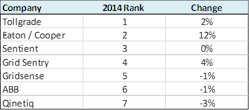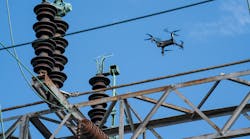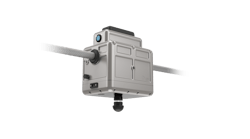The North American supply base for smart grid sensors continues to consolidate, as leading companies increased their share of the market in 2014. The combined market share of the top four suppliers comprised more than three-quarters of the total market in 2014, rising from approximately half the market the previous year. In this nascent market there is a chance that a few suppliers will dominate in the near future, while others face considerable barriers to entry.
As the market in North America began to scale in 2014, some smart grid sensor suppliers lost market share, because their product offerings had higher price points and more functionality than was commonly needed by utilities companies. Utilities tend to have very limited budgets and are still focused on fault detection and other simple smart sensing functions, compared to Volt/VAR optimization, power quality monitoring, and other more complex solutions. Companies that increased share last year have successfully positioned their sensors in the market, offering acceptable returns to utilities that are looking to solve immediate problems.
The North American market is driven by reliability, which is the leading sensor application for utilities. Locating faults quickly and restoring them is the highest priority for most electric utilities. Smart grid sensors that can perform only fault detection (for example, current measurement sensors) are much more affordable for utilities than ones that can perform voltage sensing, resulting in utilities spending more on fault circuit indicators (FCIs).
Supply-Side Changes
Suppliers that entered the market early and established credibility with utilities were able to secure larger and longer-term contracts last year and early this year. With market leaders consolidating their market share, smaller companies are having a difficult time entering into new contracts with utilities and convincing them of the value of their product offerings. As more time passes, barriers to entry will mount, preventing new companies from gaining significant share. Merging with or acquiring another company may be the only long-term route to enter the market.
Being part of a larger, well-funded grid supplier allows smaller companies the benefit of economies of scale, access to better research and development, and potentially a larger marketing budget with which to reach out to utilities. Whether merging or collaborating, efforts to work together will benefit not only stand-alone sensor suppliers, but also large multi-national companies that may be able to gain a sophisticated piece of technology with no overhead investment.
In the next year or two the current market leaders will remain at the top, because they had a head start in establishing trust and contracts with utilities. However some opportunity may still exist, as the North American market for smart grid sensors is forecast to grow three-fold, from less than $100 million in 2014 to almost $300 million in 2021, which could potentially give some smaller suppliers a chance to catch up.
As electric utilities increase the size of their smart grid sensor pilots, and as more utilities start pilots for the first time, there may be some opportunities in the next year or so for smaller sensor companies to provide value for utility clients and secure pilot contracts; however, timing is critical. The market is scaling and the market leaders are only getting stronger.



